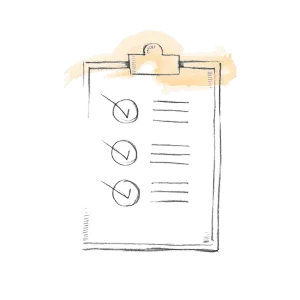











We create digital experiences that grow your business! We use a proven UX/UI process to design websites and applications that look great, are easy to use, convert well, and are ready to scale.











We’ve gathered experience and expertise in UX/UI design, offering end-to-end solutions – from research and strategy, through design systems and prototypes, to precise implementation. We work on large-scale custom projects as well as optimizing existing products, always with a focus on the user, business goals, and sustainable solutions.

Contact us to discuss your project in detail and choose the best solution together.
The process ensures a planned, flexible, and effective path to achieving your business goals.
We begin with stakeholder workshops, user interviews, and surveys to deeply understand business goals, user needs, and market context.
We analyze competitors and create user journeys and experience maps.
We dive into each client’s unique context to build a UX strategy with specific findings and recommendations — a strong foundation for a design that is impactful, functional, efficient, and sustainable.


This phase is dedicated to thoroughly examining your digital product (website or app).
We identify UX obstacles, usability issues, and opportunities for improvement. Through heuristic evaluation, usability testing, analytics, and WCAG accessibility checks, we pinpoint critical pain points.
We analyze user flows to uncover difficulties and improvement opportunities.
The result is a detailed UX report with prioritized recommendations and visual examples — a clear, actionable roadmap for optimization and improved outcomes.
We build a strong foundation for growth and sustainable product development through a design system structured using the Atomic Design model and built with Figma design tokens.
We define a clear visual language, create reusable UI components, and include documentation with usage guidelines.
Design tokens provide full visual and functional consistency, easy theme management, and smooth developer synchronization. The result is a system that accelerates processes, reduces errors, and ensures control and efficiency at scale.


We turn the concept into a validated, final digital product through high-fidelity designs, interactive prototypes, and well-structured specs.
We create a design ready for integration, based on design tokens, and collaborate closely with development teams.
We conduct final testing to ensure that the interface not only looks great but also performs flawlessly for all users (WCAG-compliant). The final result is a precise, documented, dev-ready UI system - with no compromise on user experience.
A standalone service intended for products that already exist but are struggling with conversions, user satisfaction, or compliance with accessibility and usability standards (WCAG).
Through a combination of heuristic evaluation, data analysis (Google Analytics, heatmaps), usability testing, and WCAG accessibility checks, we identify the key points of confusion, drop-off, or frustration.
We conduct moderated and remote user tests to understand not only what doesn't work — but why.
You will receive a detailed report with:
Ideal for products that need a real boost in performance, accessibility, and user satisfaction.
A standalone service intended for products that already have an established visual language but suffer from inconsistency, maintenance difficulties, and slowed development. We help you build a comprehensive design system — a stable foundation for sustainable growth.
Instead of imposing a pre-made framework, we first collaborate with your designers and developers to define a design system that works for your team. We structure your visual elements in Figma using design tokens, a reusable UI component library, and clear guidelines and workflows for both design and development. We apply Atomic Design architecture and sync the design system with your front-end to improve cross-team collaboration.
With this system you’ll achieve:
A design system isn’t a luxury — it’s a strategic tool for efficiency, control, and high-quality growth.

UI Design (User Interface Design) focuses on the visual aspect of a digital product – colors, typography, icons, buttons, and the arrangement of interface elements. Its goal is to ensure that users interact easily and pleasantly with your website or application.
A well-crafted UI enhances visual consistency, accessibility, and brand identity. At Studio Kipo, we apply principles of contrast, visual hierarchy, and responsive design to create professional and intuitive interfaces that engage users and encourage interaction.

UX Design deals with functionality, structure, and logic, while UI Design focuses on visual appearance and aesthetics.
In practice, both disciplines are closely connected – UX defines the flow and logic of interaction, and UI turns it into a clear, appealing visual experience. Together, they create digital products that are both beautiful and easy to use.

UX/UI Design directly influences conversions and customer satisfaction. When users can find what they need easily and feel confident using your site or app, the likelihood of completing a purchase rises significantly.
An intuitive interface, smooth interactions, and visual clarity build trust. Effective UX design reduces drop-offs and increases time spent on the platform – both critical factors for improving business outcomes.

The cost of UX/UI Design depends on the scope, complexity, and type of project – website, web platform, or mobile app. Typical prices start from a few thousand euro and increase based on the number of screens, level of interactivity, and prototype depth.
At Studio Kipo, each project is evaluated individually, taking into account business goals, functionality, and technical architecture to ensure the best balance between quality and value.

The UX/UI Design process typically follows these steps:
At Studio Kipo, we use a flexible methodology that ensures continuous feedback and full transparency throughout the project.

An outstanding digital experience is achieved through the right balance of functionality, clarity, and emotional engagement.
The foundation lies in a well-structured UX combined with elegant UI visuals. Applying principles like minimalism, consistency, and visual focus guides users naturally through the content while reinforcing brand trust.

Strategic UX Design is an approach where the user experience is planned in alignment with business goals. Instead of improving only the interface, it an alyzes the entire user journey and its impact on sales, loyalty, and brand communication.
This approach enables long-term growth and measurable results by integrating strategy, data, and design into a cohesive process.

UX Design (User Experience Design) is the process of planning and shaping the user experience – how people perceive, understand, and interact with a digital product. It involves research, behavioral analysis, prototyping, and usability testing.
The goal is to make every user action logical, efficient, and satisfying. UX design improves performance, reduces bounce rates, and builds a positive emotional connection between the brand and its users.

UX/UI Design is essential for the success of any website or mobile app because it determines how users interact with it. A well-structured UX and a clean UI increase user retention, improve navigation, and build trust.
For businesses, this means higher conversion rates, more sales, and a stronger brand image. Good design is not just about looks– it’s a strategic tool that delivers measurable results.

UX/UI Design covers a complete process from research to visual design, including:
Studio Kipo provides a full-cycle service, aligning each stage with your business objectives to ensure design decisions deliver real impact.

The duration of UX/UI design depends on the project’s scale and the number of pages or screens. Typically, the process takes from a few weeks to several months, depending on the project’s complexity.
The stages include research, building the structure (UX), creating visual components (UI), testing, and finalization. For more complex applications, the timeframe may be extended to ensure full compatibility between aesthetics and functionality.

Yes, Studio Kipo designs UX/UI for both websites and mobile applications.
When designing for mobile, we consider the specific requirements of iOS and Android systems, screen sizes, gestures, and user behavior. The goal is to deliver interfaces that are intuitive, responsive, and optimized for mobile experiences.

An interactive UI uses animations, transitions, and micro-interactions to make the interface feel alive and easy to understand.
Intuitiveness is achieved through consistent button styles, clear typography, and immediate visual feedback for every action.
At Studio Kipo, we apply these principles to craft interfaces that both look and feel natural to users.

Information Architecture (IA) defines the structure and organization of content within a website or application. It outlines the navigation, hierarchy, and relationships between pages and elements.
A well-planned IA helps users find the information they need quickly and enhances the overall user experience. In UX, it’s a foundational step upon which all other design layers are built.